10 Best Yeasts for Beer Brewing, According to Homebrewing Experts
I’ve tested dozens of yeast strains, and these ten consistently deliver exceptional results: SafAle US-05 for clean American ales, LalBrew Nottingham for versatile English styles, and LalBrew New England for hazy IPAs with tropical esters. Lalvin EC-1118 handles high-alcohol beers up to 18% ABV, while LalBrew Verdant produces bold fruit flavors perfect for modern IPAs. Each strain offers specific attenuation rates and temperature ranges that directly impact your beer’s final character, alcohol content, and clarity—factors that determine brewing success.
We are supported by our audience. When you purchase through links on our site, we may earn an affiliate commission, at no extra cost for you. Learn more. Last update on 4th December 2025 / Images from Amazon Product Advertising API.
Notable Insights
- SafAle US-05 delivers clean, versatile fermentation ideal for IPAs, pale ales, and stouts with excellent foam retention.
- LalBrew Nottingham offers exceptional versatility for both ales and lagers with high 78-84% attenuation and 14% alcohol tolerance.
- LalBrew Verdant IPA produces bold fruit flavors perfect for IPAs with reliable 75-82% attenuation and consistent performance.
- LalBrew VOSS Kveik enables rapid fermentation at high temperatures (95-104°F) with neutral flavor and citrus notes.
- LalBrew New England creates authentic tropical and stone fruit esters essential for traditional New England IPA styles.
North Mountain Supply SafAle US-05 Beer/Ale Yeast (Pack of 3)
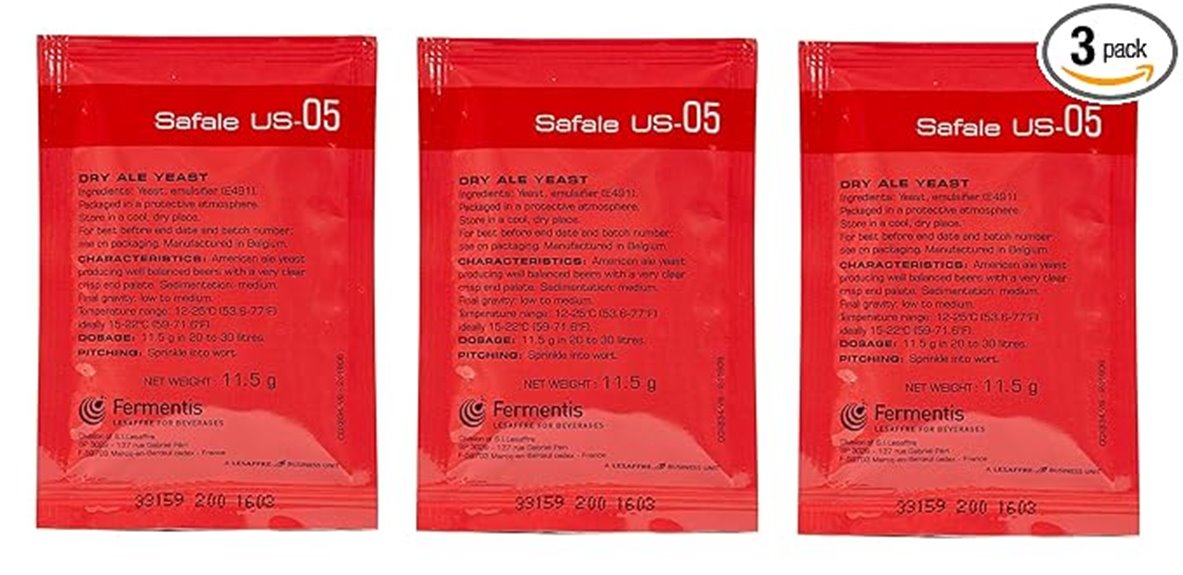
If you’re a homebrewer seeking consistent, reliable results across multiple beer styles, the North Mountain Supply SafAle US-05 Beer/Ale Yeast stands out as your go-to fermentation partner. This American ale yeast delivers clean, crisp fermentation with minimal diacetyl production, allowing your malt and hop flavors to shine through without interference. You’ll appreciate its versatility across beer styles, from IPAs and pale ales to porters and stouts. The yeast forms excellent foam heads and maintains good suspension during fermentation. North Mountain Supply, an authorized Fermentis distributor, provides fresh packets with replacement guarantees and troubleshooting support if activation issues occur before expiration.
Best For: Homebrewers who want a reliable, versatile American ale yeast that produces clean, consistent results across multiple beer styles while allowing malt and hop flavors to take center stage.
Pros:
- Delivers clean, crisp fermentation with low diacetyl production and excellent foam head formation
- Extremely versatile across beer styles from IPAs and pale ales to porters and stouts
- Comes with replacement guarantee and troubleshooting support from authorized Fermentis distributor
Cons:
- Produces neutral yeast character, which may not be desirable for styles requiring specific yeast flavors
- Some users have reported occasional fermentation issues
- Limited to ale styles only, not suitable for lager brewing
LalBrew Nottingham Brewing Yeast (2 Pack) – 11g Sachets
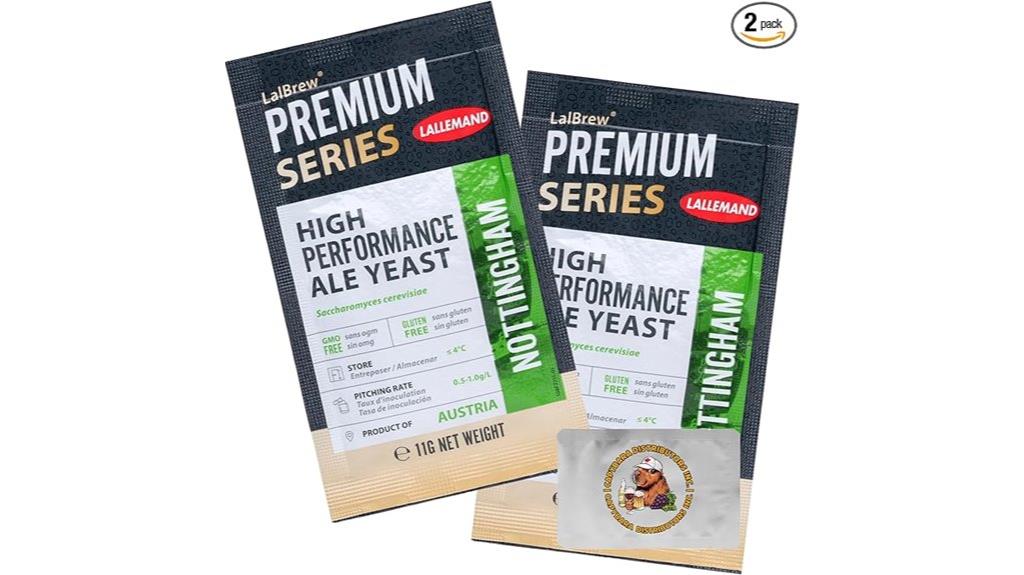
LalBrew Nottingham stands out as one of the most versatile brewing yeasts available, making it an excellent choice for homebrewers who want to experiment with multiple beer styles using a single strain. You’ll appreciate its wide temperature range of 50-77°F, which lets you brew everything from pale ales to stouts with consistent results. This Saccharomyces cerevisiae strain delivers 78-84% attenuation and handles up to 14% ABV, making it perfect for both session beers and high-gravity brews. You can pitch 50-100g per hectoliter and expect high flocculation for excellent clarity. Each 11g sachet covers five gallons easily.
Best For: Homebrewers who want a reliable, versatile yeast strain that can handle multiple beer styles from pale ales to imperial stouts with consistent performance across varying fermentation conditions.
Pros:
- Exceptional versatility – works well for traditional ales, lagers, and even experimental styles like Kölsch
- Wide temperature tolerance (50-77°F) allows brewing in various seasonal conditions without temperature control equipment
- High flocculation provides excellent clarity and easy separation from finished beer
Cons:
- Higher alcohol tolerance (14% ABV) may be overkill for brewers focused only on lower-gravity session beers
- Heritage strain characteristics may not provide the unique flavor profiles that specialty yeasts offer for specific styles
- Two-pack format may be more than needed for occasional brewers who only make beer infrequently
LalBrew Verdant IPA Brewing Yeast (2 Pack)
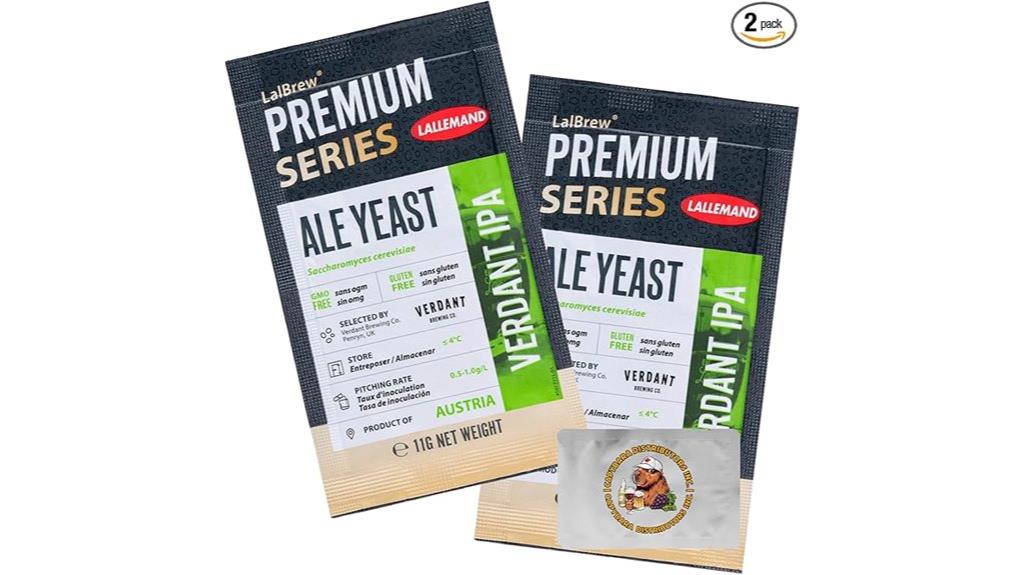
Brewers seeking to craft vibrant, hop-forward IPAs with exceptional aroma will find LalBrew Verdant IPA yeast delivers exactly what they’re looking for. This dry yeast produces prominent apricot notes with tropical fruit and citrus undertones, while promoting hop biotransformation that enhances your beer’s aroma and flavor profile.
You’ll appreciate its reliable performance characteristics: 75-82% attenuation, medium flocculation, and fermentation temperatures between 64-77°F. The yeast starts working within 24-36 hours and handles up to 12% ABV without stalling.
Each 11g sachet works perfectly for 5-gallon batches, and you won’t need starters like liquid yeasts require. It creates a soft, balanced mouthfeel that’s ideal for NEIPAs, American Pales, and English IPAs.
Best For: Homebrewers who want to create vibrant, hop-forward IPAs and NEIPAs with prominent fruit flavors and enhanced hop aroma without the complexity of liquid yeast starters.
Pros:
- Delivers bold apricot, tropical fruit, and citrus flavors while promoting hop biotransformation for enhanced aroma
- Reliable fermentation performance with 75-82% attenuation, no stalling, and starts working within 24-36 hours
- Convenient dry yeast format that doesn’t require starters and is easy to store and pitch for 5-gallon batches
Cons:
- Limited to ale styles only – not suitable for lagers or malt-driven beer styles
- Sachet size is specifically designed for 5-gallon batches, requiring adjustments for smaller or larger brew volumes
- May produce too much fruitiness for brewers seeking completely neutral yeast character
Red Star Distillers Yeast (DADY), 1 lb.
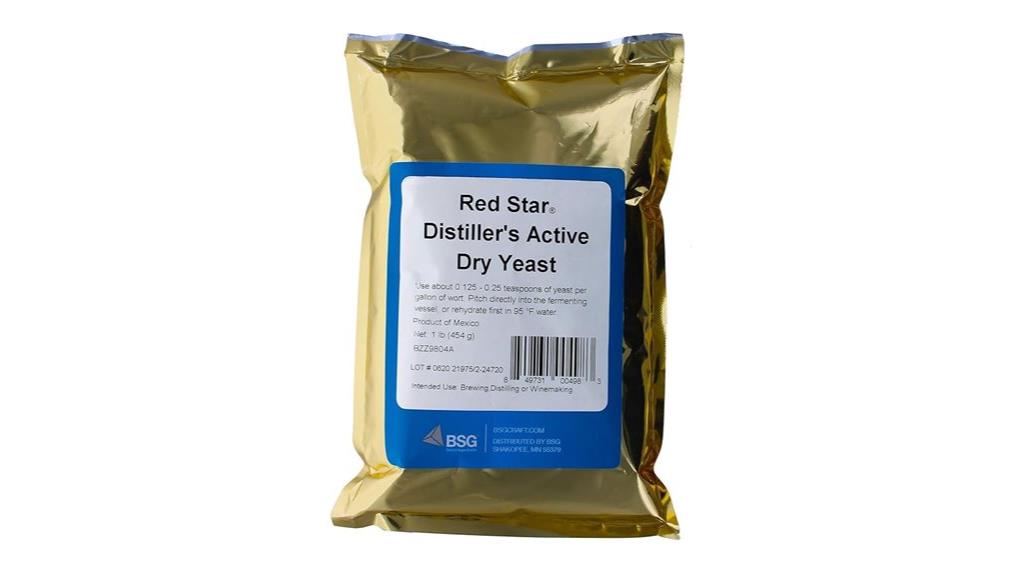
Red Star Distillers Yeast (DADY) stands out as an excellent choice for homebrewers who want maximum alcohol production from their fermentation projects. You’ll get impressive fermentation power that reaches up to 22% alcohol before slowing down. This one-pound package provides enough yeast to ferment up to 500 gallons, making it cost-effective for multiple brewing sessions.
You’ll find DADY works well for various projects beyond beer, including mead and even baking applications. However, you should be cautious when ordering during summer months since heat can affect yeast viability. Some brewers report needing sugar water and nutrients to activate less-than-perfect batches, so proper yeast preparation remains important for consistent results.
Best For: Homebrewers and distillers who want high-alcohol fermentation projects and need large quantities of yeast for multiple batches.
Pros:
- Achieves impressive alcohol levels up to 22% before fermentation slows
- Excellent value with enough yeast to ferment up to 500 gallons from one pound
- Versatile for various applications including beer, mead, and even baking projects
Cons:
- Heat sensitivity during shipping can affect yeast viability, especially in summer
- May require additional nutrients and sugar water activation for optimal performance
- Some users report inconsistent results requiring proper yeast preparation techniques
LalBrew VOSS Kveik Brewing Yeast (2 Pack)
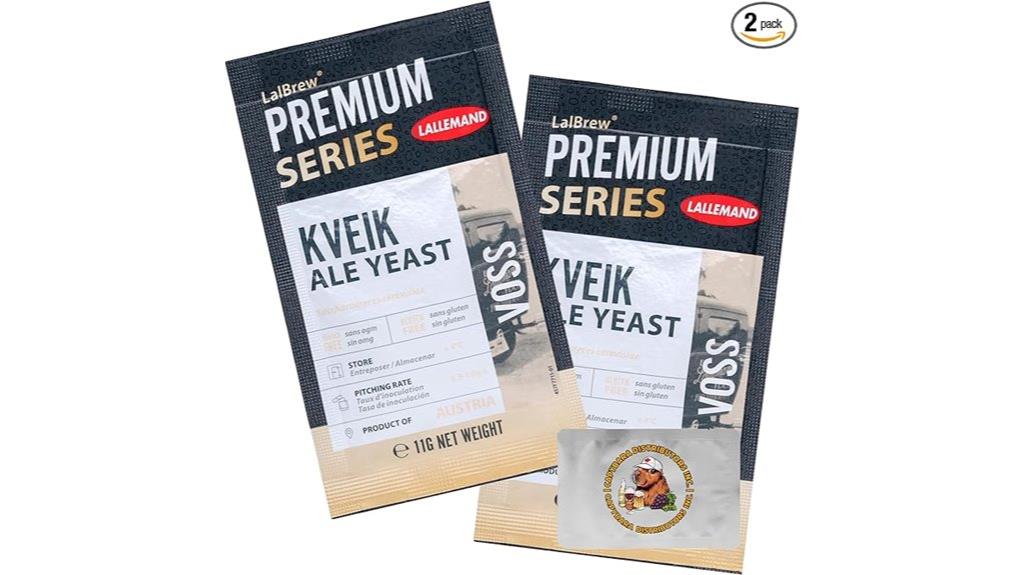
LalBrew VOSS Kveik stands out as the ideal choice for homebrewers who want lightning-fast fermentation without sacrificing quality or flavor consistency. You’ll see bubbles within 1-2 hours of pitching, and fermentation typically completes in just 2-3 days. This Norwegian farmhouse yeast thrives at high temperatures between 95-104°F, making it perfect for warm brewing conditions that would stress other yeasts. You’ll achieve 76-82% attenuation with very high flocculation, creating clear beer quickly. The flavor profile remains neutral with subtle orange and citrus notes across all temperatures. Each 2-pack contains 11g sachets that work excellently for ales, hard seltzers, and Northern European-style brews.
Best For: Homebrewers who want extremely fast fermentation times and need a yeast that performs reliably in warm brewing conditions while producing neutral, clean-tasting ales.
Pros:
- Lightning-fast fermentation with bubbles appearing in 1-2 hours and complete fermentation in just 2-3 days
- Thrives in high temperatures (95-104°F) where other yeasts would struggle or produce off-flavors
- Very high flocculation creates clear beer quickly with consistent neutral flavor profile across all temperature ranges
Cons:
- Limited to neutral flavor profiles, which may not suit brewers seeking more complex yeast character
- Requires higher pitching rates (50-100g/hL) compared to some other yeast strains
- May not be suitable for traditional styles that benefit from longer, slower fermentation processes
Craft A Brew Safale US-05 American Ale Dry Yeast (1 Pack)
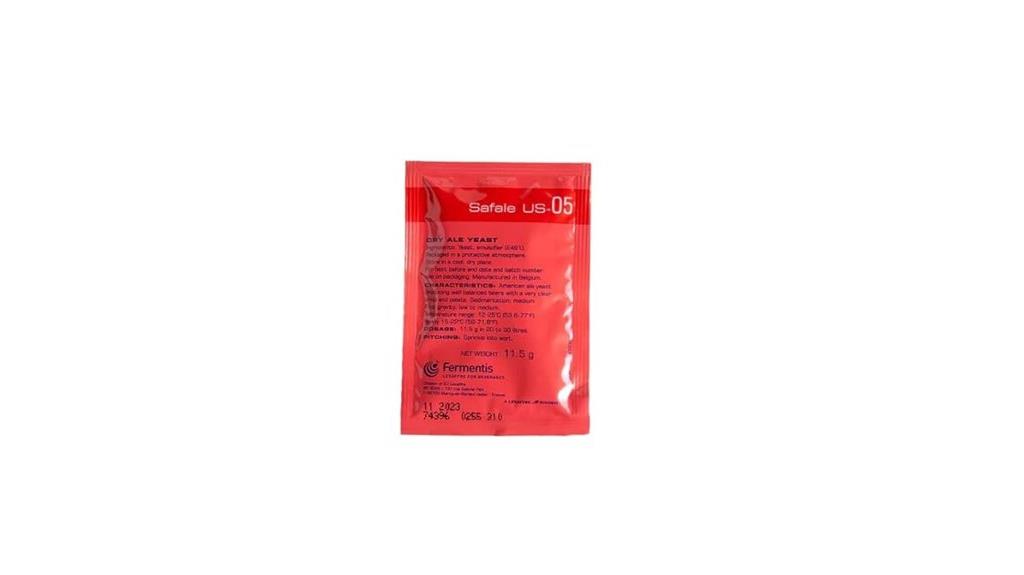
Homebrewers seeking a reliable, no-fuss yeast for American-style ales will find their perfect match in Craft A Brew’s Safale US-05 American Ale Dry Yeast. This premium dry yeast delivers consistently clean, neutral flavors that won’t overpower your hop profiles. You’ll appreciate its versatility across pale ales, IPAs, porters, stouts, and even ciders.
The yeast thrives at 65-74°F fermentation temperatures and requires no hydration or starter preparation. You can pitch it directly into your wort and expect fermentation to complete within 12 days. It promotes excellent foamy head retention while maintaining a crisp, clean palate in your finished beer. Store it refrigerated and check expiration dates for ideal performance.
Best For: Homebrewers who want a reliable, easy-to-use dry yeast that produces clean, neutral-flavored American-style ales without requiring hydration or starter preparation.
Pros:
- No hydration or yeast starter required – can be pitched directly into wort for convenient brewing
- Versatile across multiple beer styles including pale ales, IPAs, porters, stouts, and even ciders
- Fast fermentation timeline completing within 12 days with excellent foamy head retention
Cons:
- Mixed user reviews with some brewers experiencing activation issues
- Performance can be affected by storage conditions and expiration dates that may not always be clearly verified
- Limited to neutral flavor profiles, so not ideal for brewers seeking distinctive yeast character in their beers
LalBrew Nottingham English Ale Brewing Yeast (1 Pack)
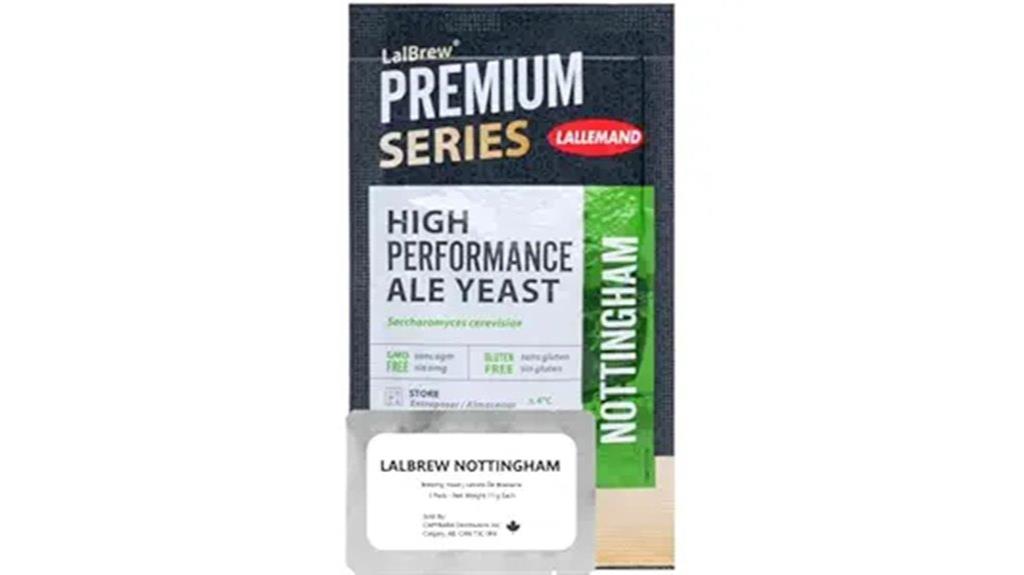
When you’re seeking a reliable yeast that performs consistently across multiple beer styles, LalBrew Nottingham English Ale Yeast stands out as an exceptional choice for both novice and experienced brewers. This high-performance Saccharomyces cerevisiae strain delivers 78-84% attenuation with high flocculation, making cleanup easier after fermentation. You’ll appreciate its wide temperature range of 50-77°F and impressive 14% alcohol tolerance. The yeast provides neutral flavor characteristics, allowing your malt and hop profiles to shine through clearly. It works exceptionally well for traditional styles like pale ales, porters, and stouts, plus modern variations including IPAs and lager-style beers. Each 11-gram sachet pitches at 50-100g/hL rates.
Best For: Both novice and experienced brewers seeking a versatile, reliable yeast that performs consistently across multiple beer styles while providing neutral flavor characteristics that allow malt and hop profiles to shine through.
Pros:
- High performance with 78-84% attenuation and high flocculation for easier cleanup after fermentation
- Exceptional versatility working well for both traditional styles (pale ales, porters, stouts) and modern variations (IPAs, lager-style beers)
- Wide operating parameters with 50-77°F temperature range and impressive 14% alcohol tolerance
Cons:
- Single 11-gram sachet may require multiple packs for larger batch sizes depending on pitching rate needs
- Neutral flavor profile may not contribute desired yeast character for styles that benefit from distinctive yeast flavors
- Higher-end pitching rate of 100g/hL could make it more expensive per batch compared to lower pitching rate yeasts
LalBrew New England Brewing Yeast (2 Pack) – American Ale Yeast
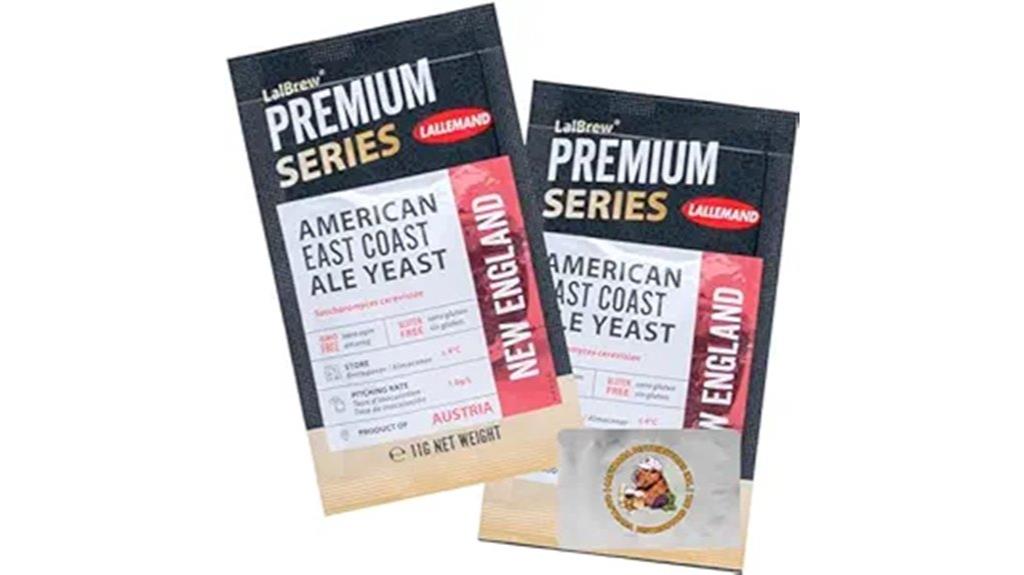
Craft brewers seeking that signature hazy, fruit-forward character in their New England IPAs will find their perfect match in LalBrew New England yeast. This Saccharomyces cerevisiae strain delivers tropical and stone fruit esters, particularly peach notes, while achieving 78-83% attenuation. You’ll get excellent results fermenting between 64-77°F with medium flocculation characteristics.
What sets this yeast apart is its β-glucosidase enzyme activity, which enhances hop biotransformation for intensified aroma and flavor. The strain handles up to 9% ABV and works perfectly for NEIPAs and East Coast ales. Each pack contains two 11-gram sachets, giving you flexibility for multiple batches or larger volumes.
Best For: Craft brewers who want to create authentic New England IPAs and East Coast ales with signature hazy appearance, tropical fruit esters, and enhanced hop aroma through natural biotransformation.
Pros:
- Produces distinctive peach and tropical fruit esters that define the NEIPA style
- Contains β-glucosidase enzyme that naturally enhances hop flavor and aroma through biotransformation
- Comes in convenient 2-pack format allowing flexibility for multiple batches or larger brew volumes
Cons:
- Limited to 9% ABV alcohol tolerance, restricting use in higher-alcohol beer styles
- Medium flocculation may require additional clarification steps for clearer beer styles
- Specialized strain primarily suited for New England/East Coast ales, limiting versatility across other beer styles
Factors to Consider When Choosing Yeast for Beer
Now that I’ve covered some excellent yeast options, I’ll help you understand the key factors that’ll guide your yeast selection process. Choosing the right yeast isn’t just about grabbing any strain off the shelf—you need to match specific characteristics to your brewing goals and beer style. I’ll walk you through the essential considerations including beer style compatibility, temperature requirements, alcohol tolerance, and attenuation rates that’ll make or break your brew.
Several vital factors determine whether your chosen yeast will produce the beer you’re envisioning or leave you with disappointing results.
I’ll break down the essential considerations that’ll guide your yeast selection process. First, examine the attenuation range, which typically varies from 75% to 84% for ale strains and directly affects your beer’s final alcohol content. Temperature tolerance matters greatly—most ale yeasts perform best between 64°F to 77°F, influencing both fermentation speed and flavor development.
Consider flocculation characteristics, as this determines how well your yeast settles after fermentation, affecting clarity and mouthfeel. Alcohol tolerance is vital too, with many ale yeasts handling up to 14% ABV before performance drops. Each factor works together to shape your final product’s character and quality.
Beer Style Compatibility
When you’re selecting yeast for your homebrew, matching the strain to your intended beer style isn’t just recommended—it’s essential for achieving authentic flavors and characteristics.
I’ve learned that different yeast strains create distinct flavor profiles that define beer styles. For New England IPAs, you’ll want strains that produce fruity esters, while American ales benefit from yeasts delivering clean, crisp finishes.
Traditional ales like Porters and Stouts require yeasts with higher attenuation rates between 78% to 84% for ideal flavor extraction and body. Consider flocculation characteristics too—high flocculation strains work perfectly for clear beers, while low flocculation creates cloudy appearances that enhance flavor.
For stronger beers like Barleywines, I recommend strains with high alcohol tolerance up to 18% ABV, whereas lighter styles need lower tolerance yeasts to prevent over-attenuation.
Temperature Range Requirements
Temperature control stands as one of the most critical factors you’ll face when selecting yeast for your homebrew project. I’ve learned that yeast strains operate within specific temperature ranges, typically between 10°C to 40°C (50°F to 104°F). Most ale yeasts perform best at 18°C to 25°C (64°F to 77°F), while specialized strains like Kveik can handle temperatures up to 40°C (104°F).
You’ll need to monitor temperatures closely because extreme fluctuations create sluggish fermentation and off-flavors. I recommend matching your yeast choice to your fermentation environment’s capabilities. Temperature directly affects attenuation levels, which typically range from 75% to 84%, and influences flocculation behavior that determines your beer’s final clarity and quality.
Alcohol Tolerance Levels
Beyond temperature considerations, alcohol tolerance becomes your next major decision point when selecting the right yeast strain for your brewing project.
I need to match my yeast’s alcohol tolerance with my target beer strength. Most brewing yeasts handle 9% to 18% ABV, but this varies greatly between strains. If I’m brewing standard ales or lagers, typical beer yeasts work fine at 12-14% tolerance. However, when I’m crafting high-gravity beers like Imperial Stouts or Barleywines, I’ll need yeasts that can survive higher alcohol levels.
Choosing the wrong tolerance level creates real problems. If my yeast can’t handle the alcohol it’s producing, fermentation stalls halfway through, leaving me with unwanted residual sugars and an unfinished beer. For extreme strength beers, I might even consider champagne yeasts that tolerate up to 22% ABV.
Attenuation Percentage
Attenuation percentage determines how much sugar your yeast will actually consume during fermentation, directly affecting your beer’s final sweetness and alcohol content.
Most brewing yeasts I recommend fall between 70% to 85% attenuation. When you choose a yeast with higher attenuation, you’ll get a drier, more alcoholic beer. Lower attenuation strains leave more residual sugars behind, creating sweeter profiles that work well for styles like stouts or porters.
I’ve found that your actual attenuation depends on several factors beyond the yeast strain itself. Fermentation temperature, nutrient availability, and yeast health all influence how much sugar gets converted. Understanding these attenuation characteristics helps you match the right yeast to your desired beer style and flavor profile, ensuring consistent results batch after batch.
Flocculation Characteristics
Flocculation determines how well your yeast cells clump together and drop out of solution once fermentation wraps up. This characteristic directly impacts your beer’s clarity and whether you’ll need additional filtration steps.
High-flocculating yeasts settle quickly to the bottom, leaving you with crystal-clear beer that requires minimal filtering. I recommend these strains for lagers and other styles where clarity matters most. Medium to low-flocculating yeasts stay suspended longer, creating hazier brews that work perfectly for hefeweizens and New England IPAs.
Consider your target beer style when selecting yeast flocculation levels. High-flocculating strains can finish fermentation faster but might struggle with subsequent batches if you’re reusing yeast. Low-flocculating varieties give you that desired haze but require more patience during clarification.
Flavor Profile Impact
Your yeast selection creates the foundation of your beer’s flavor profile, often determining whether you’ll taste bright citrus notes, warm spice, or clean malt character in your final product. Different strains produce unique esters and phenols that contribute distinct fruity, floral, or spicy characteristics to your brew. I recommend choosing high-attenuation yeasts for drier beers, as they’ll allow your malt and hop flavors to shine through more prominently. Temperature control becomes essential here—warmer fermentation temperatures encourage more fruity esters, while cooler conditions produce subtler flavors. If you’re brewing hop-forward styles like IPAs, select strains known for biotransformation abilities that enhance hop aroma and flavor. Remember, your yeast choice directly impacts whether your beer finishes clean and crisp or complex and characterful.
Fermentation Speed
Beyond flavor considerations, fermentation speed plays a major role in your brewing timeline and overall process management. I’ve found that yeast attenuation range directly correlates with fermentation speed—higher attenuation typically means faster conversion of sugars to alcohol.
If you’re looking for speed, Kveik strains are game-changers. They’ll ferment at temperatures up to 104°F and complete fermentation in just 2-3 days, compared to traditional ale yeasts that need a week or more. Temperature control becomes essential here, as most yeasts perform faster within their ideal ranges.
I recommend choosing strains with vigorous activity that start fermenting within 24-36 hours after pitching. This predictable behavior helps you plan your brewing schedule effectively and reduces the risk of stalled fermentation.
On a final note
I’ve covered the top yeast options that’ll help you brew better beer at home. Each strain brings unique characteristics to your final product, from clean American ales to complex English styles. Remember to match your yeast choice with your beer style, fermentation temperature, and alcohol tolerance needs. Start with reliable strains like US-05 or Nottingham if you’re new to brewing. With the right yeast selection, you’ll consistently produce flavorful, well-fermented beer every time.
